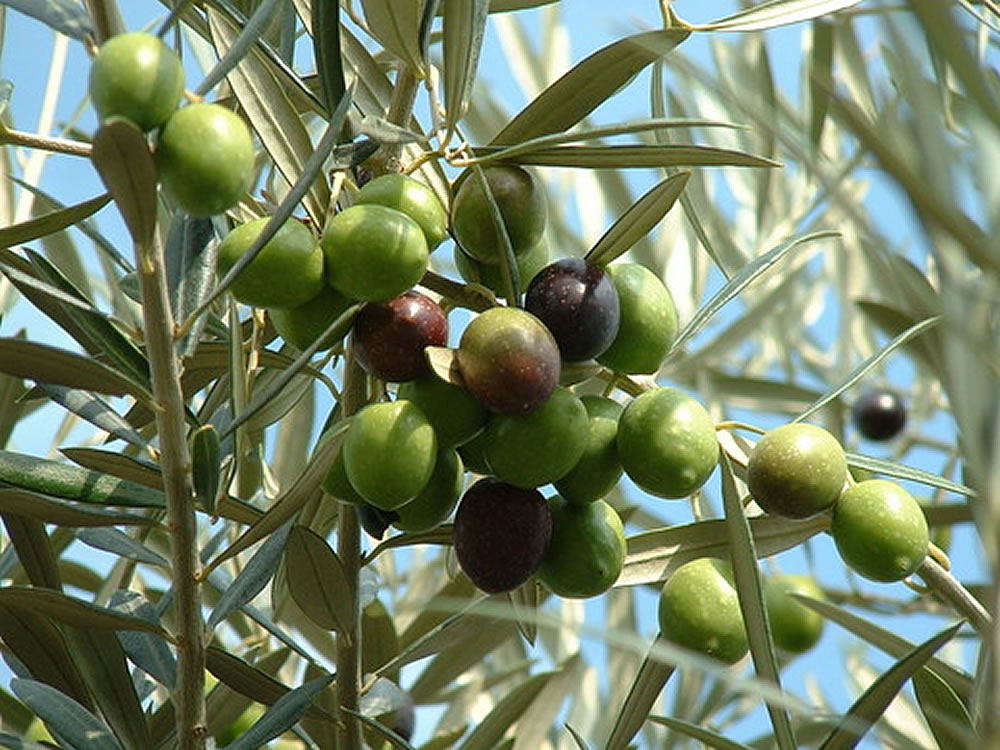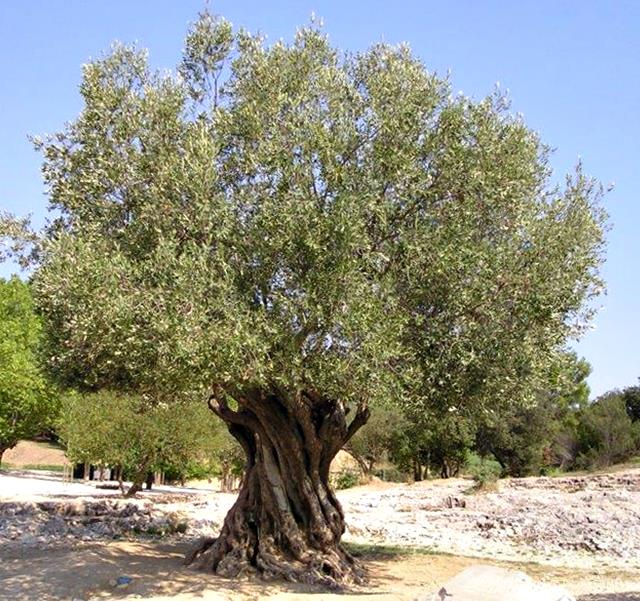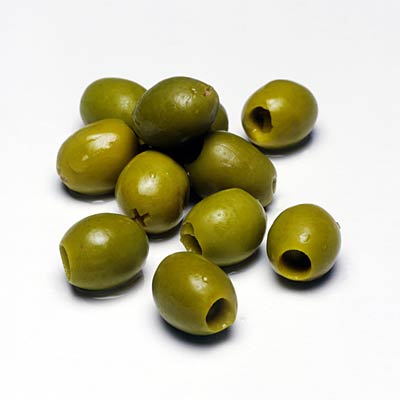VANILLA BEANS | SOYBEAN OIL | SOYMEAL & CAKE | COCOA BEANS | COFFEE BEANS
How to grow OLIVE TREES in Uganda
 Olive tree with fruits in Uganda
Olive tree with fruits in UgandaThe olive, known by the botanical name Olea europaea, meaning "European olive", is a species of small tree in the family Oleaceae,
Olive is one of the most characteristic evergreen tree crops.
The tree is tolerant to drought and would make suitable option to areas with limited water availability.
In some western cultures the olive is sacred that it represents virtue, victory, productivity and peace.
The olive industry is big but rather untraceable in Uganda because Olive trees are not commonly grown.
The fruits of an olive tree are used to make products like the olive oil and many more.
Common Olive tree varieties in Uganda
The cultivar of olives to produce depends on whether the olives are meant for oil production or grown as table olives. Recommended varieties for the sub Saharan region include;
- Mission - black table olive and olive oil
- Kalamata - black table olive
- Manzanilla - green table olive
- Barouni - green queen table olive
- Frantoio - high-quality olive oil and cross-pollinator
Contact us here to buy Olive tree Fruits and Olive Seedlings in Uganda
Soil requirements for growing Olive trees in Africa
Olives can be grown on marginal soils but would rather recommend well draining soils with a pH above 5.0, and most importantly rich in nitrogen, potassium and boron mineral compounds.
How to propagate Olive tree on your farm
Olive trees can be propagated by using several methods such as grafting of young wood on seedlings of cloned rootstocks or by the rooting of hardwood, semi hardwood or softwood cuttings.
The method used, will depend on the cultivar, facilities that are available as well as the expertise of the grafter.
How to propagate Olive tree on your farm
Olive trees can be propagated by using several methods such as grafting of young wood on seedlings of cloned rootstocks or by the rooting of hardwood, semi hardwood or softwood cuttings.
The method used, will depend on the cultivar, facilities that are available as well as the expertise of the grafter.
Contact us here to buy Olive tree Fruits and Olive Seedlings in Uganda
How to plant Olive Trees in Uganda
 Mature Olive Tree in Uganda
Mature Olive Tree in UgandaAn olive tree has a life span of at least 30 years.
It’s therefore, important to select the correct locality and prepare the soil properly.
Seedlings for planting should be obtained from the nursery when they are 18 months old.
To plant make a square-shaped planting hole in the middle of the previously prepared hole.
This planting hole should not be deeper than the original length of the plastic bag carrying the seedling.
Much care should be taken not to damage the roots or allow the roots to dry out.
The roots should not come in contact with any fertilizer or manure which was applied into the planting hole as it could result in scorching.
After placing the seedling into the hole, pack the soil firmly around the roots and irrigated directly after planting.
The trees should be supported with sturdy bamboo of wooden stakes and tied with decomposable twine in order to ensure upright growth and to prevent wind damage.
The stems of the trees can be protected for the first couple of years by painting it with whitewash or white PVA paint.
Another important activity in growing olives is pruning and training.
The lifespan of an olive orchard will be determined by the pruning strategy that is followed.
Pruning should be kept to a minimum during the first few years.
Only those branches which are obstructing the growth of other branches or which grow near the soil surface should be removed.
Have an integrated pest management strategy on nematodes, leaf-rollers, seed wasp and diseases like anthracnose, and olive leaf spot.
Contact us here to buy Olive tree Fruits and Olive Seedlings in Uganda
How best to Harvest Olive fruits in Africa
Harvesting is another laborious activity in commercial olive production.
The mode of harvesting is subject to the end use of the olive fruit.
Fruits intended for processing as ripe-black olives should be picked when have turned completely black.
Those intended for oil harvesting should be harvested when most of the trees on the tree are ripe.
The oil content within the fruit increases as the fruit colors and ripens.
To harvest, pick the olives meant for food by hand and place them carefully in picking bags.
Care should be taken not to damage the fruit during the picking.
Olives for oil production can be stripped for a faster process.
Contact us here to buy Olive tree Fruits and Olive Seedlings in Uganda
About the Market and uses of the Olive tree
 Olive Fruits in Uganda
Olive Fruits in UgandaOlive tree fruits can be sold to Olive Oil producing companies to process oils, or even processed and sold in supermarkets or farmer markets as table olives.
Olive oil has long been considered sacred. The olive branch was often a symbol of abundance, glory, and peace. The leafy branches of the olive tree were ritually offered to deities and powerful figures as emblems of benediction and purification, and they were used to crown the victors of friendly games and bloody wars. Today, olive oil is still used in many religious ceremonies. Over the years, the olive has also been used to symbolize wisdom, fertility, power, and purity.
The olive was one of the main elements in ancient Israelite cuisine. Olive oil was used for not only food and cooking, but also lighting, sacrificial offerings, ointment, and anointment for priestly or royal office. The olive tree is one of the first plants mentioned in the Hebrew Bible (the Christian Old Testament), and one of the most significant. An olive branch was brought back to Noah by a dove to demonstrate that the flood was over (Book of Genesis, 8:11). The olive is listed in Deuteronomy 8:8 as one of the seven species that are noteworthy products of the Land of Israel.
The olive tree, Olea europaea, has been cultivated for olive oil, fine wood, olive leaf, and the olive fruit. About 90% of all harvested olives are turned into oil, while about 10% are used as table olives. The olive is one of the "trinity" or "triad" of basic ingredients in Mediterranean cuisine, the other two being wheat for bread, pasta, and couscous, and the grape for wine.
Contact us here to buy Olive tree Fruits and Olive Seedlings in Uganda
Quick Tips for planting oranges in Africa
- Clear up land meant for the orchard to leave it weed free.
- Open up planting holes 80cm deep and a meter wide in width and length.
- Gently release the seedlings from the polybag and agitate the root zone to release the roots a bit.
- Place the seedling in the hole then cover with the soil mixture.
- Gently firm to remove air pockets.
- Water and also stake the seedling to protect it from strong winds and animals.
- Prune when the branches start to stretch out, as this is vital to fruit production.
Contact us here to buy Olive tree Fruits and Olive Seedlings in Uganda
Have a Question or Great Story About This Plant Guide?
Do you have a Question or Comment about this plant Guide? Then Share it!
Uganda Plant Guides , Industry News & Business Opportunities plus Guide Updates
Click below to see the articles from page contributors and comments from visitors to the Uganda Plants Guide...
New farmer of olive trees
I would like know if olive trees for fruit table and for oil can grow in kisoro district.where can I buy them from uganda.I stay in kampala.
fruits production on olive tree
we have an olive tree planted in our church compound 10yrs back but so far it has not shown any signs of producing fruits. is there something wrong or …
If you haven't yet found what you were looking for or you need detailed information about the subject matter on this page then... feel free to ask our business travel consultants. |




